How to get rid of skunks? (Humanely)
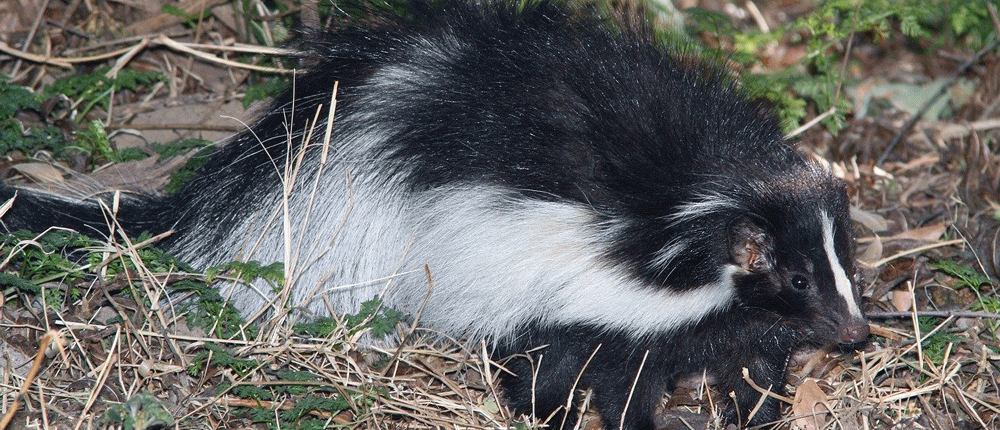 Skunks can be a huge nuisance when they decide to make themselves comfortable in your yard. They forage in gardens and rubbish, dig holes in an attempt to feast on insects, and for poultry owners, they pose a threat to chickens and their eggs. These creatures may dig under your house as well, thus causing damage to your home and its wiring. When deciding how to get rid of skunks on your property, you need to understand that there’s a risk of being sprayed, therefore plan accordingly. The following tips can be used to get rid of these animals humanely.
Skunks can be a huge nuisance when they decide to make themselves comfortable in your yard. They forage in gardens and rubbish, dig holes in an attempt to feast on insects, and for poultry owners, they pose a threat to chickens and their eggs. These creatures may dig under your house as well, thus causing damage to your home and its wiring. When deciding how to get rid of skunks on your property, you need to understand that there’s a risk of being sprayed, therefore plan accordingly. The following tips can be used to get rid of these animals humanely.
Eliminate Food Sources
Remove any sources of food around your yard. These include pet food bowls, fallen fruits from fruit trees, or low-hanging bird feeders. Secure feeders to make sure they can’t be overturned, and practice due diligence in cleaning up any spilled seed. When experiencing skunk problems, it is best to either feed your pets indoors or clean up all traces of leftovers as soon as feeding time is over. You should avoid putting kitchen scraps in your compost pit and keep it well covered until you no longer experience these pests. It is also important to mow your lawn because skunks love insects that live in lush grass. Cutting off all possible food sources is necessary to starve these critters and send them packing to search for greener pastures.
Use Sound or Ultrasonic Repellents
When you find the skunk den, you can put a radio in it and disturb their peace, causing them to flee. However, this may be a source of disturbance for you and your neighbors. A better alternative is to use high-frequency ultrasonic repellents which can only be heard by these animals. The noise will irritate the skunks and send them packing.
Protect Your Waste
Skunks are known for scavenging in trash cans and can survive on garbage alone. It is therefore necessary to keep your trash cans properly sealed with tight-fitting, locking lids. If possible, you should store your garbage bins in an enclosed place at night so that their smells don’t attract skunks. The ones that live around your property will soon be starved when they run out of food from your garbage, therefore leaving them no choice but to vacate.
Liquid and Granular Skunk Repellents
Skunks have a very strong sense of smell which they use to locate food. Olfactory repellents attempt to use the skunks’ sense of smell against them by filling the atmosphere with odors that are repugnant to skunks. You can sprinkle or spray the repellent around your property and in known skunk dens. Commercial skunk repellents are available in stores and online but you can make it at home with the right ingredients. However, if they are not irritable enough to the skunks, it may not be as effective. Homemade repellents come with the responsibility of frequent applications. This is because elements such as rain and wind easily wear down on their scent and taste due to their mild ingredients. You can make a homemade repellent using a mixture of hot peppers, onion, jalapeno, cayenne pepper, and water. Boil for a few minutes then strain and pour inside a spray bottle and you’re good to go! Each dose should last up to 5 days.
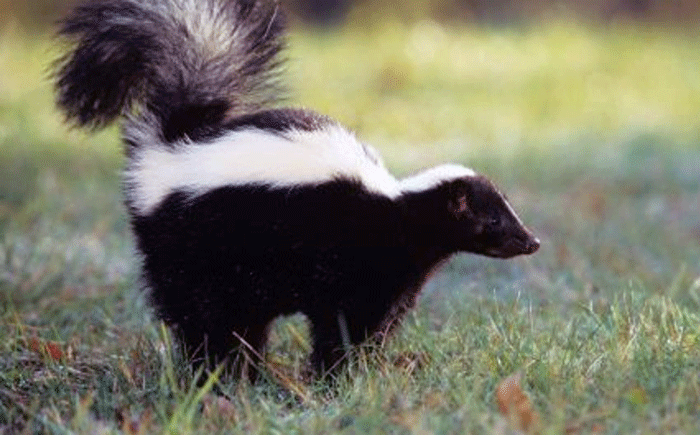
Predator urine can work as well, including the urine of your pets (if you’re somehow able to collect it). You can also purchase it in stores around your area. The downside to using it is that it requires reapplication every 24 hours and can easily be washed away when it rains. Ammonia can also be used by soaking rags in buckets filled with the chemical and placing them around the perimeter of your yard.
Electronic Skunk Repellents
The motion detector sprinkler is an effective repellent because it conditions the skunks to fear, thus deterring them from your property. It senses the heat and motion of these pests. Once detected, the sprinkler sprays a burst of water while creating a “ticking” sound which startles the animal. This will make the skunks reluctant to venture back into your property. An electronic yard protector can also be used to repel these creatures. It generates powerful ultrasonic sound waves which creates a very high pitch, high sound pressure environment that is incredibly uncomfortable and annoying to animals. The sound is inaudible to humans and can be tuned specifically for the type of animal you want to get rid of by adjusting the knob at the back of the unit.
Deterrent Lights
Skunks are nocturnal and shy away from bright lights. Placing lights around your property will make it less appealing to these animals. Predator deterrent lights are designed to scare away nocturnal animals by mimicking another predator’s eyes. They emit powerful LED lights that have visibility capabilities for up to half a mile. Since the lights will be on all night, consider using energy-saving or solar lighting to minimize the cost of electricity bills. You could also install a motion sensor that is activated when a skunk nears its proximity.
Skunk Traps
Before planning to trap a skunk, ensure that it’s legal to do so in your area. In some instances, you may need to seek the help of a professional trapper. While it may be relatively easy to trap a skunk, the risk of them spraying requires some special care. The ideal size of the trap should be large enough for them to move somewhat comfortably, but small enough to deter them from lifting their tail high enough to spray. Spring-loaded traps are used to lure the skunk inside with bait then close the door behind it so as to prevent escape. You can use peanut butter, canned sardines, cat food, or other strong-scented foods to bait the trap. Place it near the skunk’s access route to your property or its den. Once trapped, carry the animal away from your property and set it free in the woods or an open wild area. While transporting it, ensure that you take careful steps to avoid making the skunk feel threatened, thus spraying. When releasing it, ensure your face is positioned away from the exit door of the trap to avoid being sprayed.
How to Trap a SKUNK?
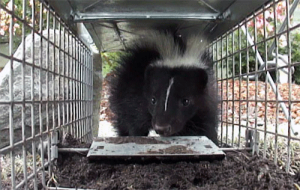 Skunks are naturally cautious animals; therefore, it is important to ensure that the trap is not too outstanding. The creature may not go in if the trap looks like a human addition to the scenery. You can use several precautions such as washing the trap with warm water to remove any human scent on it. The best traps for skunks are about 25-35 inches long. They should be big enough so that the skunk can move around somewhat comfortably, but not high enough to let it raise its tail to spray. It is unlikely for it to spray when it can’t lift its tail high up.
Skunks are naturally cautious animals; therefore, it is important to ensure that the trap is not too outstanding. The creature may not go in if the trap looks like a human addition to the scenery. You can use several precautions such as washing the trap with warm water to remove any human scent on it. The best traps for skunks are about 25-35 inches long. They should be big enough so that the skunk can move around somewhat comfortably, but not high enough to let it raise its tail to spray. It is unlikely for it to spray when it can’t lift its tail high up.
Type of Trap
When trapping a skunk, it is important to ensure that the trap is well covered because they spray if they see you. You can use polythene panels which are hinged to fit over the sides and top of the trap. Most style traps require you to manually lift and hold open the door in order to release the skunk. Unless you are a professional, Havahart recommends using a type of trap that has a lever at the back of the trap to open the door. This mechanism ensures that you are fully clear of the door, thus fewer chances of getting sprayed.
Bait
As scavengers, skunks usually depend on their keen sense of smell when trying to find food sources. This means that you should use strong scented foods in order to draw the animal in. The most effective baits are known to be meat-based such as tuna, raw chicken entrails, cat food, and sardines, among others. If you run the risk of trapping a cat instead, you could use sweeter treats such as bread coated with peanut butter or marshmallows. The bait has to be positioned in a way that lures the skunk all the way inside and encourages it to step on the trigger plate of the trap.
Trap Placement
When determining trap placement, you should consider areas where you’ve seen the most skunk damage or where it frequents. Usually, people seem to have problems with them going under decks, porches, sheds, and the like. If you are able to pinpoint your skunk’s den, place your trap 5-10 feet from the entrance. Position it on an even surface to ensure stability because skunks are strong animals and can tip over the trap if they see it as a hindrance to getting food or shelter. If the skunk isn’t taking residence in your yard but is gaining access to your property through a hole in the fence, you could simply place the trap over the hole and wait for the skunk to be entrapped.
Since skunks are nocturnal, you should set your trap in the evening or at dusk. If the cage is empty the next morning, you should close it so as not to trap any unwanted critters, and then set it again in the evening. It is necessary to check the trap often to ensure that the skunk doesn’t remain trapped for long as it can be detrimental to its health. To release a trapped skunk, stand more than 20 feet away and release the trap door using a string or fishing line.
HOW TO KEEP SKUNKS FROM DIGGING UNDER MY HOUSE, DECK OR SHED
Skunks will dig holes in your deck, shed or house to find a cozy shelter. They burrow their way under in order to find a suitable habitat for reproducing. If you are experiencing a skunk infestation, you can be certain that they will be reproducing on your property. If they die in an inaccessible place, the odor is nerve-wrenching and can cause great discomfort to the inhabitants of that house. Luckily, there are some ways through which you can avoid this issue.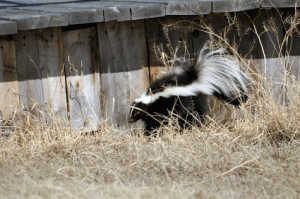 Remove Possible Den Sites
Remove Possible Den Sites
You should get rid of wood, debris piles, rocks, or any other cover that would attract foraging skunks and encourage them to make a home within your property. Skunks usually dig their own dens, but use spaces under houses, decks and sheds if available. Therefore, spaces beneath your deck and porch should be closed off to keep skunks from making their den there. You can skunk proof these areas using heavy gauge galvanized hardware cloth.
Eliminate Entry Points
It is advisable to cover openings with concrete, sheet metal, or wire mesh. The mesh should be tightly fitted because skunks can squeeze through spaces as small as 4 inches wide. The mesh should be bent at a right angle and extended at least 12 inches away or outward from the location. If your area has loose sandy soil, you should increase the depth and length of the mesh. In northern climates where skunks are even more motivated to find shelter due to the cold, you may need to bury the mesh deeper. In addition to this, you should bury hardware cloth and attach it to the lower edge of the structure, or weave tight fences 2 inches below the ground.
Use Deterrents and Repellents
Skunks are scavengers, meaning that they have a heightened sense of smell which they use to locate food. In order to use their senses against them, you can soak old rags in ammonia and place them under your house, deck, or shed. They will be deterred by the pungent smell of the chemical and ditch that area. However, use caution when handling ammonia because it can be toxic if mishandled. Since ammonia evaporates, you will need to re-soak the rags once they dry out in order for them to be effective in deterring skunks. Sprinkling cayenne pepper around those areas can be effective as well because skunks do not enjoy their intense smell and flavor.
Since they are nocturnal creatures, skunks avoid well-lit areas. Bright lights are known to be one of the most effective natural skunk repellents. If possible, you can install LED lights under the areas where skunks frequent. Putting motion-sensing lights near these areas is also a good idea because they startle them and make them avoid getting closer. If these methods still prove to be ineffective in preventing these creatures from digging, you should consider hiring a professional. It is important to know the rules and regulations pertaining to your local jurisdiction while dealing with skunk issues in order to know the proper methods to use to get rid of them.
HOW TO KEEP SKUNKS OFF MY YARD OR PROPERTY
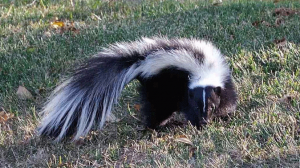 Having skunks around your yard or property can present a number of health and safety hazards. They are known to be carriers of rabies and other diseases that may pose a threat to your family or pets. Skunks are scavengers, so they use their keen sense of smell to search for food around your garden, trash bags, and other areas of your property. They dig burrows (sometimes under decks and porches) so that they can raise their young in summer and live in semi-hibernation during the cold winter months.
Having skunks around your yard or property can present a number of health and safety hazards. They are known to be carriers of rabies and other diseases that may pose a threat to your family or pets. Skunks are scavengers, so they use their keen sense of smell to search for food around your garden, trash bags, and other areas of your property. They dig burrows (sometimes under decks and porches) so that they can raise their young in summer and live in semi-hibernation during the cold winter months.
Eliminate Possible Den Sites
Wood and rock piles as well as debris around your property increase the chances of a skunk infestation. When these creatures are looking for places to breed, even a junked out car can be an option! It is therefore a necessary precaution to clear away any debris around your property in order to keep the skunks away.
Clean Out Any Food Sources
Skunks are naturally known to be shy creatures that avoid human contact at all costs. Therefore, if one happens to find its way into your yard or property, it must have a very compelling reason to be there. These creatures have a keen sense of smell and are quick to smell any food in your property. To keep them away, you need to ensure that your trash can is securely covered. In case you have an open compost pile, you need to ensure that you find a way to seal it because skunks are not so choosy when it comes to picking up meals. If you have pets, you can either feed them indoors or clear any remains left including their feeding bowls.
Build a Fence Around Your Yard
Skunks are generally not good climbers. This is why building a fence around your property is a good idea. Fruits and vegetables growing in your yard are an attractant to these animals. A fence can act as a barrier to them scavenging on fallen fruit in your garden. However, a motivated critter can dig under the fence, thus consider burying several inches of fence in order to deter them from accessing your yard. The Ministry of Forests, Wildlife and Parks recommends using wire mesh with openings of 5 cm or less, and stakes between 1.5 and 1.8 m high.
Install Lights Around Your Property
Being nocturnal creatures, skunks don’t like bright lights. It is best to consider putting motion activated floodlights because they often startle the skunks and scare them off. When doing this, it is important to put several factors into consideration such as the direction from which the skunks are coming. The lights will be more effective in keeping the skunks away if they face the right direction. Since these lights will be on all night, it is best to consider one that recharges using solar power in order to lower electricity bills.
Use Skunk Repellents
Sprinkling your fence with natural repellents such as cayenne pepper can discourage skunks from digging under and gaining access to your yard or property.
